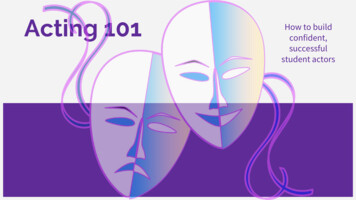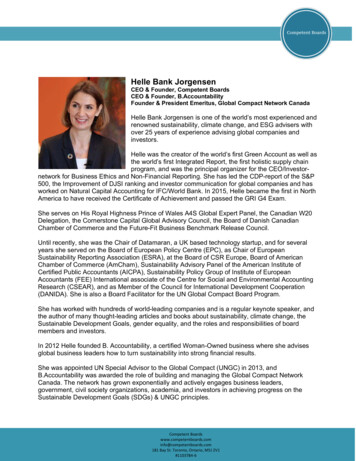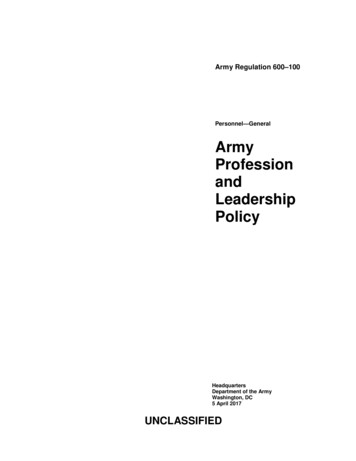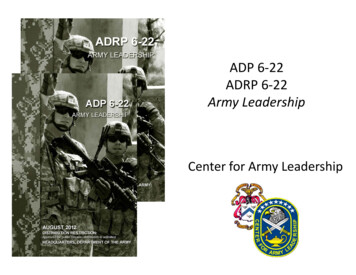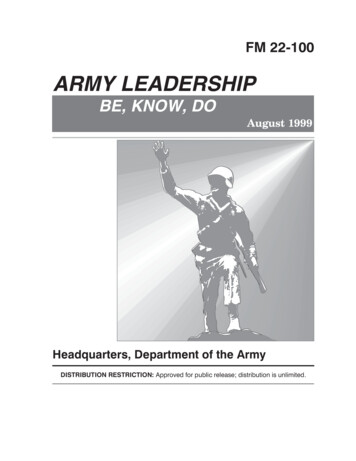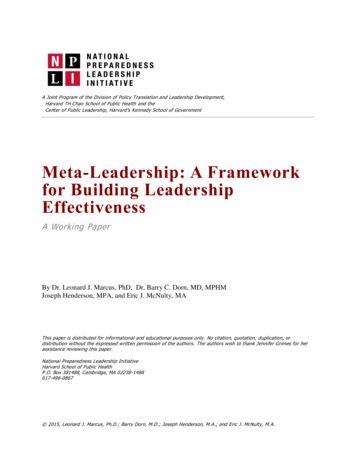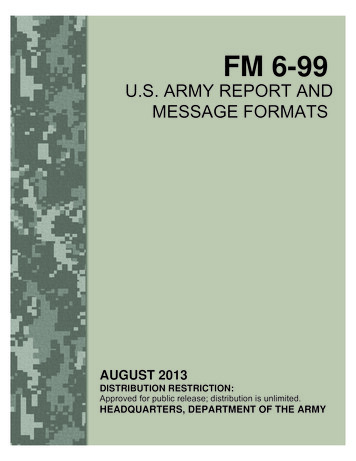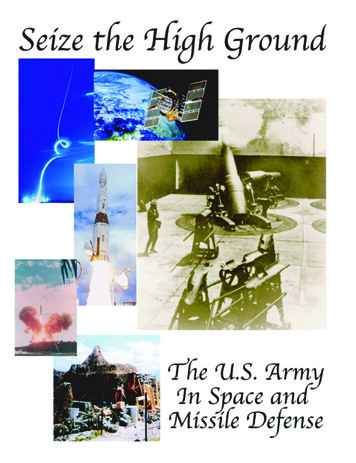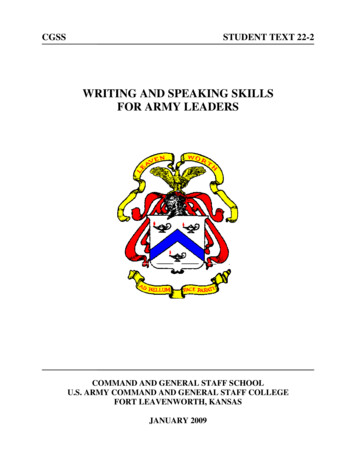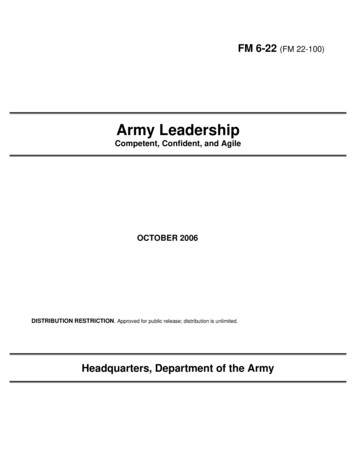
Transcription
FM 6-22 (FM 22-100)Army LeadershipCompetent, Confident, and AgileOCTOBER 2006DISTRIBUTION RESTRICTION. Approved for public release; distribution is unlimited.Headquarters, Department of the Army
ForewordCompetent leaders of character are necessary for the Army to meet the challenges in thedangerous and complex security environment we face.FM 6-22 is the Army’s keystone field manual on leadership. It establishes leadershipdoctrine and fundamental principles for all officers, noncommissioned officers, andArmy civilians across all components.This manual uses the BE-KNOW-DO concept to express what is required of Armyleaders. It is critical that Army leaders be agile, multiskilled pentathletes who havestrong moral character, broad knowledge, and keen intellect. They must display theseattributes and leader competencies bound by the concept of the Warrior Ethos. Leadersmust be committed to lifelong learning to remain relevant and ready during a career ofservice to the Nation.Army leaders must set the example, teach, and mentor, and this manual provides theprinciples, concepts, and training to accomplish this important task on which Americadepends.PETER J. SCHOOMAKERGeneral, United States ArmyChief of ne(www.us.army.mil) and General Dennis J. Reimer Training and DoctrineDigital Library at (www.train.army.mil).
*FM 6-22 (FM 22-100)HeadquartersDepartment of the ArmyWashington, DC, 12 October 2006Field ManualNo. 6-22Army LeadershipCompetent, Confident, and AgileContentsPagePREFACE .vACKNOWLEDGEMENTS.viINTRODUCTION .viiiPART ONETHE BASIS OF LEADERSHIPChapter 1LEADERSHIP DEFINED . 1-1Influencing . 1-2Operating. 1-3Improving . 1-3Chapter 2THE FOUNDATIONS OF ARMY LEADERSHIP. 2-1The Founding Documents of our Nation . 2-1The Civilian-Military Linkage . 2-1Leadership and Command Authority. 2-3The Army Leadership Requirements Model. 2-3Excelling at the Core Leader Competencies. 2-7Chapter 3LEADERSHIP ROLES, LEADERSHIP LEVELS, AND LEADERSHIP TEAMS3-1Roles and Relationships. 3-1Levels of Leadership . 3-5Leader Teams . 3-8Team Structures . 3-9PART TWOChapter 4THE ARMY LEADER: PERSON OF CHARACTER, PRESENCE ANDINTELLECTLEADER CHARACTER. 4-1Army Values . 4-2Empathy. 4-9The Warrior Ethos . 4-10Character Development . 4-12Character and Beliefs . 4-12Character and Ethics . 4-14Distribution Restriction: Approved for public release; distribution is unlimited.This publication supersedes FM 22-100, 31 August 1999.i
ContentsChapter 5LEADER PRESENCE .5-1Military and Professional Bearing .5-1Health Fitness .5-2Physical Fitness .5-2Confidence .5-2Resilience.5-3Chapter 6LEADER INTELLIGENCE.6-1Mental Agility.6-1Sound Judgment.6-2Innovation.6-2Interpersonal Tact .6-3Domain Knowledge.6-5PART THREE COMPETENCY-BASED LEADERSHIP FOR DIRECT THROUGHSTRATEGIC LEVELSChapter 7LEADING .7-3Leads Others.7-4Extends Influence Beyond the Chain of Command.7-11Leads by Example .7-13Communicates .7-14Chapter 8DEVELOPING.8-1Creates a Positive Environment.8-1Prepares Self .8-6Develops Others .8-9Chapter 9ACHIEVING .9-1Providing Direction, Guidance, and Priorities .9-1Developing and Executing Plans .9-2Accomplishing Missions.9-5Competencies Applied for Success .9-7Chapter 10INFLUENCES ON LEADERSHIP .10-1Challenges of the Operating Environment.10-1Stress In Combat .10-4Stress in Training .10-7Dealing With the Stress of Change.10-7Tools for Adaptability .10-8PART FOUR LEADING AT ORGANIZATIONAL AND STRATEGIC LEVELSChapter 11ORGANIZATIONAL LEADERSHIP .11-1Leading .11-1Developing .11-4Achieving.11-8Chapter 12STRATEGIC LEADERSHIP .12-1Leading .12-2Developing .12-9Achieving.12-13iiFM 6-2212 October 2006
ContentsAppendix ALEADER ATTRIBUTES AND CORE LEADER COMPETENCIES.A-1Appendix BCOUNSELING.B-1Types of Developmental Counseling . B-1The Leader as a Counselor. B-4The Qualities of the Counselor. B-4Accepting Limitations. B-6Adaptive Approaches to Counseling . B-8Counseling Techniques. B-8The Four-Stage Counseling Process . B-9Summary—The Counseling Process at a Glance . B-14Glossary. Glossary-1References.References-1Index. Index-1FiguresFigure 2-1. The Army Values . 2-2Figure 2-2. The Army leadership requirements model. 2-4Figure 2-3. Eight core leader competencies and supporting behaviors. 2-7Figure 3-1. The NCO vision. 3-3Figure 3-2. The Army civilian corps creed. 3-4Figure 3-3. Army leadership levels. 3-6Figure 4-1. The Soldier’s Creed .4-10Figure 8-1. Stages of team building .8-18Figure A-1. The Army leadership requirements model .A-1Figure A-2. Competency of leads others and associated components and actions.A-2Figure A-3. Competency of extends influence beyond the chain of command andassociated components and actions.A-3Figure A-4. Competency of leads by example and associated components andactions.A-4Figure A-5. Competency of communicates and associated components and actions .A-5Figure A-6. Competency of creates a positive environment and associatedcomponents and actions .A-6Figure A-7. Competency of prepares self and associated components and actions.A-7Figure A-8. Competency of develops others and associated components and actions .A-8Figure A-9. Competency of gets results and associated components and actions .A-9Figure A-10. Attributes associated with a leader of character (identity) . A-10Figure A-11. Attributes associated with a leader with presence . A-10Figure A-12. Attributes associated with a leader with intellectual capacity. A-11Figure B-1. Support activities .B-7Figure B-2. Counseling approach summary chart.B-8Figure B-3. Example of a counseling outline. B-1012 October 2006FM 6-22iii
ContentsFigure B-4. Example of a counseling session. B-12Figure B-5. A summary of counseling. B-14Figure B-6. Example of a developmental counseling form—event counseling . B-15Figure B-7. Example of a developmental counseling form—event counseling(reverse) . B-16Figure B-8. Example of a developmental counseling form—performance/professionalgrowth counseling. B-17Figure B-9. Example of a developmental counseling form—performance/professionalgrowth counseling (reverse) . B-18Figure B-10. Guidelines on completing a developmental counseling form . B-19Figure B-11. Guidelines on completing a developmental counseling form (reverse). B-20ivFM 6-2212 October 2006
PrefaceAs the keystone leadership manual for the United States Army, FM 6-22 establishes leadership doctrine, thefundamental principles by which Army leaders act to accomplish their mission and care for their people.FM 6-22 applies to officers, warrant officers, noncommissioned officers, and enlisted Soldiers of all Armycomponents, and to Army civilians. From Soldiers in basic training to newly commissioned officers, newleaders learn how to lead with this manual as a basis.FM 6-22 is prepared under the direction of the Army Chief of Staff. It defines leadership, leadership roles andrequirements, and how to develop leadership within the Army. It outlines the levels of leadership as direct,organizational, and strategic, and describes how to lead successfully at each level. It establishes and describesthe core leader competencies that facilitate focused feedback, education, training, and development across allleadership levels. It reiterates the Army Values. FM 6-22 defines how the Warrior Ethos is an integral part ofevery Soldier’s life. It incorporates the leadership qualities of self-awareness and adaptability and describestheir critical impact on acquiring additional knowledge and improving in the core leader competencies whileoperating in constantly changing operational environments.In line with evolving Army doctrine, FM 6-22 directly supports the Army’s capstone manuals, FM 1 andFM 3-0, as well as keystone manuals such as FM 5-0, FM 6-0, and FM 7-0. FM 6-22 connects Army doctrineto joint doctrine as expressed in the relevant joint doctrinal publications, JP 1 and JP 3-0.As outlined in FM 1, the Army uses the shorthand expression of BE-KNOW-DO to concentrate on key factorsof leadership. What leaders DO emerges from who they are (BE) and what they KNOW. Leaders are preparedthroughout their lifetimes with respect to BE-KNOW-DO so they will be able to act at a moment’s notice andprovide leadership for whatever challenge they may face.FM 6-22 expands on the principles in FM 1 and describes the character attributes and core competenciesrequired of contemporary leaders. Character is based on the attributes central to a leader’s make-up, andcompetence comes from how character combines with knowledge, skills, and behaviors to result in leadership.Inextricably linked to the inherent qualities of the Army leader, the concept of BE-KNOW-DO representsspecified elements of character, knowledge, and behavior described here in FM 6-22.This publication contains copyrighted material.This publication applies to all men and women of all ranks and grades who serve in the Active Army, ArmyNational Guard/Army National Guard of the United States, Army Reserve, and Army civilian workforce unlessotherwise stated.Terms that have joint or Army definitions are identified in both the glossary and the text. Glossary references:Terms for which FM 6-22 is the proponent field manual (the authority) are indicated with an asterisk in theglossary. Text references: Definitions for which FM 6-22 is the proponent field manual are printed in boldfacein the text. These terms and their definitions will be incorporated into the next revision of FM 1-02. For otherdefinitions in the text, the term is italicized and the number of the proponent manual follows the definition.U.S. Army Training and Doctrine Command is the proponent for this publication. The preparing agency is theCenter for Army Leadership, Command and General Staff College. Send written comments andrecommendations on DA Form 2028 (Recommended Changes to Publications and Blank Forms) to Center forArmy Leadership ATTN: ATZL-CAL (FM 6-22), 250 Gibbon Avenue, Fort Leavenworth, KS 66027-2337.Send comments and recommendations by e-mail to calfm622@leavenworth.army.mil. Follow the DA Form2028 format or submit an electronic DA Form 2028.12 October 2006FM 6-22v
AcknowledgementsThe copyright owners listed here have granted permission to reproduce material from their works. Othersources of quotations and material used in examples are listed in the source notes.The example Colonel Chamberlain at Gettysburg is adapted from John J. Pullen, The Twentieth Maine (1957;reprint, Dayton, OH, Press of Morningside Bookshop, 1980). Reprinted with permission of the Estate of JohnPullen via The Balkin Agency, Inc.The section on Vertical Command Teams in Chapter 3 is reproduced from IDA Document D-2728 by LTG(ret.) Frederic J. Brown “Vertical Command Teams” (Alexandria, VA: Institute for Defense Analysis, 2002).The quotation by Douglas E. Murray in Chapter 3 is reproduced from Dennis Steele, “Broadening the PictureCalls for Turning Leadership Styles,” Army Magazine, December 1989. Copyright 1989 by the Associationof the United States Army and reproduced by permission.The example Shared Leadership Solves Logistics Challenges in Chapter 3 is adapted from the website article,John Pike, “Operation Enduring Freedom-Afghanistan” (http://www.globalsecurity.org, March 2005).The quotation by William Connelly in Chapter 4 is reproduced from William Connelly, “NCOs: It’s Time toGet Tough,” Army Magazine, October 1981. Copyright 1981 by the Association of the United States Armyand reproduced by permission.The example Task Force Kingston is adapted from Martin Blumenson, “Task Force Kingston,” ArmyMagazine,
Center for Army Leadership, Command and General Staff College. Send written comments and recommendations on DA Form 2028 (Recommended Changes to Publications and Blank Forms) to Center for

